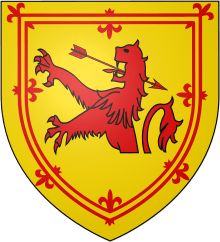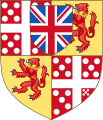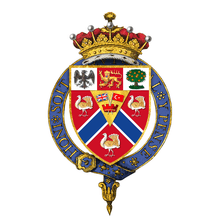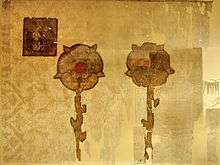Augmentation of honour
In heraldry, an augmentation (often termed augmentation of honour or sometimes augmentation of arms) is a modification or addition to a coat of arms, typically given by a monarch as either a mere mark of favour, or a reward or recognition for some meritorious act. The grants of entire new coats by monarchs as a reward are not augmentations, but rather grants of arms, and (in theory) an augmentation mistakenly given to someone who did not have a right to a coat would be nugatory.
| Part of a series on |
| Heraldic achievement |
|---|
| External devices in addition to the central coat of arms |
|
|
Augmentations could be of any kind: an ordinary, a charge, or a partition of the field. Most often it involves a chief or a canton, which contains a part or the entirety of the arms of the sovereign, which he concedes to a loyal vassal. Not all modifications to a coat of arms are augmentations of honour. Brisures, for example, are for the cadet lines of the dynasty, which are made by adding a label, bend, bordure, etc.
A common case of augmentations of honour are French cities having in their arms a chief Azure, three fleurs de lys or, also known as the "chief of France", given to cities "faithful" to the king. The new Bourgogne-Franche-Comté region has also granted the right to Rémi Mathis, who has created their new coat of arms, to bear them himself en surtout. Grand Priors of the Order of Saint John of Jerusalem bore augmentations On a chief gules a cross argent, known as a "chief of the Order of Saint John of Jerusalem".[1]
In Scotland the most frequent augmentation is the double tressure flory counter-flory, the most recognizable part of the Scottish royal arms, for example as granted (in a somewhat ironic usage) by the English King Henry VIII to Thomas Howard, 2nd Duke of Norfolk (an Englishman) after his victory over the Scots at the Battle of Flodden. A more bona fide one was granted by King Charles II (King of England and Scotland) to William Drummond, 1st Viscount Strathallan (c.1617–1688), a Scots nobleman and Royalist during the Civil War. Other forms of Scottish augmentations were granted, for example, to Sir Alexander Campbell, 1st Baronet who received an augmentation "a chief argent charged with a rock proper subscribed Gibraltar, between two medals for Seringapatam and Talavera" commemorating his part in the Great Siege of Gibraltar.
Examples
.svg.png) Thomas Howard, 2nd Duke of Norfolk was given an augmentation (shown to the right) to commemorate the Battle of Flodden.[2]
Thomas Howard, 2nd Duke of Norfolk was given an augmentation (shown to the right) to commemorate the Battle of Flodden.[2] Thomas Howard's augmentation, a modified version of the Royal coat of arms of Scotland with an arrow through the lion's mouth.
Thomas Howard's augmentation, a modified version of the Royal coat of arms of Scotland with an arrow through the lion's mouth. The 1st Duke of Wellington was given an augmentation of the Flag of the United Kingdom in the form of a shield.[2]
The 1st Duke of Wellington was given an augmentation of the Flag of the United Kingdom in the form of a shield.[2] Original family arms of 1st Viscount Nelson and the final version with all his augmentations[3]
Original family arms of 1st Viscount Nelson and the final version with all his augmentations[3] The 1st Earl Kitchener's arms with several augmentations commemorating his service in Sudan and Egypt. The shield is encircled with the Order of the Garter
The 1st Earl Kitchener's arms with several augmentations commemorating his service in Sudan and Egypt. The shield is encircled with the Order of the Garter Some of the Juliusbanner given by pope Julius II to the Swiss cantons and their associates included augmentations or "improvements"; shown here is the banner of Rapperswil, with the two roses of the city's coat of arms rendered in gold instead of the usual red.
Some of the Juliusbanner given by pope Julius II to the Swiss cantons and their associates included augmentations or "improvements"; shown here is the banner of Rapperswil, with the two roses of the city's coat of arms rendered in gold instead of the usual red.
Emperor Charles V, who was also King of Spain, granted to Juan Sebastián Elcano, the surviving commander of the Ferdinand Magellan expedition that first circumnavigated the world, an augmentation of arms consisting of a world globe with the words Primus circumdedisti me (Latin: "You first encircled me").[4] Charles V's grandmother Isabella I of Castille added a pomegranate to her coat of arms in honor of the capture of Granada.
References
- See for example arms of Thomas Dowcra
- Brooke-Little, J.P., FSA (1978) [1950]. Boutell's Heraldry (Revised ed.). London: Frederick Warne LTD. pp. 125–127. ISBN 0-7232-2096-4.
- The Heraldry Society: Horatio Viscount Nelson, access date 2 April 2015
- Nobiliario de conquistadores de Indias. Madrid: Sociedad de Bibliófilos Españoles. 1892. p. 57.
External links
| Wikimedia Commons has media related to Category:Augmentation in heraldry. |